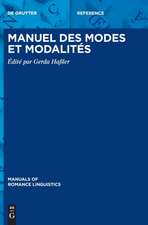The Cambridge Handbook of Romance Linguistics: Cambridge Handbooks in Language and Linguistics
Editat de Adam Ledgeway, Martin Maidenen Limba Engleză Paperback – 13 iun 2024
| Toate formatele și edițiile | Preț | Express |
|---|---|---|
| Paperback (1) | 285.18 lei 3-5 săpt. | +64.36 lei 7-13 zile |
| Cambridge University Press – 13 iun 2024 | 285.18 lei 3-5 săpt. | +64.36 lei 7-13 zile |
| Hardback (1) | 951.85 lei 6-8 săpt. | |
| Cambridge University Press – 6 iul 2022 | 951.85 lei 6-8 săpt. |
Din seria Cambridge Handbooks in Language and Linguistics
-
 Preț: 257.36 lei
Preț: 257.36 lei -
 Preț: 419.58 lei
Preț: 419.58 lei -
 Preț: 282.02 lei
Preț: 282.02 lei - 14%
 Preț: 989.26 lei
Preț: 989.26 lei -
 Preț: 282.53 lei
Preț: 282.53 lei -
 Preț: 280.50 lei
Preț: 280.50 lei -
 Preț: 338.63 lei
Preț: 338.63 lei -
 Preț: 297.50 lei
Preț: 297.50 lei -
 Preț: 281.54 lei
Preț: 281.54 lei -
 Preț: 280.68 lei
Preț: 280.68 lei -
 Preț: 347.32 lei
Preț: 347.32 lei -
 Preț: 421.82 lei
Preț: 421.82 lei -
 Preț: 284.94 lei
Preț: 284.94 lei -
 Preț: 282.45 lei
Preț: 282.45 lei -
 Preț: 417.89 lei
Preț: 417.89 lei - 14%
 Preț: 880.31 lei
Preț: 880.31 lei -
 Preț: 419.22 lei
Preț: 419.22 lei -
 Preț: 315.13 lei
Preț: 315.13 lei -
 Preț: 284.81 lei
Preț: 284.81 lei - 23%
 Preț: 977.84 lei
Preț: 977.84 lei - 19%
 Preț: 498.63 lei
Preț: 498.63 lei - 23%
 Preț: 1493.38 lei
Preț: 1493.38 lei -
 Preț: 419.93 lei
Preț: 419.93 lei - 19%
 Preț: 451.06 lei
Preț: 451.06 lei - 23%
 Preț: 949.76 lei
Preț: 949.76 lei - 23%
 Preț: 1066.00 lei
Preț: 1066.00 lei - 14%
 Preț: 989.04 lei
Preț: 989.04 lei -
 Preț: 370.92 lei
Preț: 370.92 lei - 23%
 Preț: 1075.01 lei
Preț: 1075.01 lei - 23%
 Preț: 1023.97 lei
Preț: 1023.97 lei - 11%
 Preț: 507.18 lei
Preț: 507.18 lei - 23%
 Preț: 753.13 lei
Preț: 753.13 lei -
 Preț: 473.75 lei
Preț: 473.75 lei -
 Preț: 468.73 lei
Preț: 468.73 lei - 23%
 Preț: 1027.19 lei
Preț: 1027.19 lei
Preț: 285.18 lei
Nou
Puncte Express: 428
Preț estimativ în valută:
54.57€ • 57.13$ • 45.15£
54.57€ • 57.13$ • 45.15£
Carte disponibilă
Livrare economică 15-29 martie
Livrare express 01-07 martie pentru 74.35 lei
Preluare comenzi: 021 569.72.76
Specificații
ISBN-13: 9781108454506
ISBN-10: 110845450X
Pagini: 986
Dimensiuni: 170 x 244 x 53 mm
Greutate: 1.54 kg
Ediția:Nouă
Editura: Cambridge University Press
Seria Cambridge Handbooks in Language and Linguistics
ISBN-10: 110845450X
Pagini: 986
Dimensiuni: 170 x 244 x 53 mm
Greutate: 1.54 kg
Ediția:Nouă
Editura: Cambridge University Press
Seria Cambridge Handbooks in Language and Linguistics
Cuprins
1. Data, theory, and explanation: The view from Romance Adam Ledgeway and Martin Maiden; Part I. What is a language?: 2. Origins of Romance Nigel Vincent; 3. Documentation and sources Alive Andreose and Laura Minervini; 4. Variation in Romance Diego Pescarini and Michele Loporcaro; Part II. Phonetics and phonology: 5. Structure of the syllable Giovanna Marotta; 6. Sandhi phenomena Max W. Wheeler and Paul O'Neill; 7. Effects of stress Judith Meinschaefer; 8. The notion of the phoneme Benedetta Baldi and Leonardo M. Savoia; 9. Typologically exceptional phenomena in romance phonology Eulàlia Bonet and Francesc Torres-Tamarit; Part III. Morphology: 10. Phonological and morphological conditioning Franck Floricic and Lucia Molinu; 11. The autonomy of morphology Louise Esher and Paul O'Neill; 12. Suppletion Martin Maiden and Anna M. Thornton; 13. Inflexion, derivation, compounding Chiara Cappellaro and Judith Meinschaefer; 14. Evaluative suffixes Antonio Fortin and Franz Rainer; 15. Counting systems Brigitte L.M. Bauer; Part IV. Syntax: 16. Argument structure and argument realization Víctor Acedo-Matellán, Jaume Mateu and Anna Pineda; 17. Agreement Roberta D'Alessandro; 18. Alignment Sonia Cyrino and Michelle Sheehan; 19. Complex predicates Adina Dragomirescu, Alexandru Nicolae, and Gabriela Pană Dindelegan; 20. Dependency, licensing, and the nature of grammatical relations Anna Cardinaletti and Giuliana Giusti; 21. Parametric variation Adam Ledgeway and Norma Schifano; Part V. Semantics and pragmatics: 22. Word meanings and concepts Steven N. Dworkin; 23. Key topics in semantics: Presupposition, anaphora, (in)definite nominal phrases, deixis, tense and aspect, negation Chiara Gianollo and Giuseppina Silvestri; 24. Speech acts, discourse, and clause type Alice Corr and Nicola Munaro; 25. Address systems and social markers Federica Da Milano and Konstanze Jungbluth; 26. Information structure Silvio Cruschina, Ion Giurgea, and Eva-Maria Remberger; Part VI. Language, society, and the individual: 27. Register, genre, and style in the Romance languages Christopher Pountain and Rodica Zafiu; 28. Contact and borrowing Francesco Gardani; 29. Diamesic variation Maria Selig; 30. Social factors in language change and variation John Charles Smith; Index.

